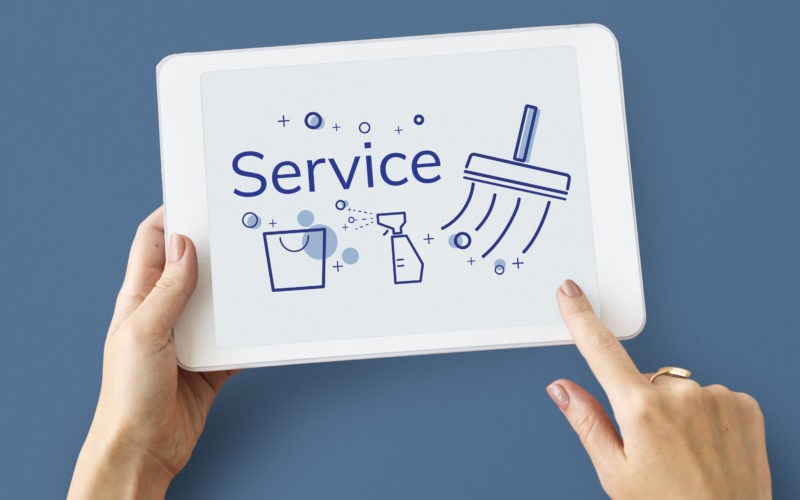Running a service-oriented company requires more than just offering top-quality work to clients. It involves juggling numerous tasks, such as managing schedules, handling payments, communicating with clients and employees, tracking inventory, and ensuring overall operational efficiency. As your company grows, the complexities of these tasks also increase. What once felt manageable can soon turn into an overwhelming challenge.
Efficiency is key as your cleaning business grows. Whether you’re running a small team or managing an expanding operation, the need for streamlined processes becomes critical. Without the right tools and systems in place, it’s easy to get bogged down with administrative tasks, leaving less time for what truly matters — delivering exceptional services to your clients and growing your company.
While managing daily operations manually might have been feasible in the early stages, growth demands a shift toward more efficient methods. This is where the integration of modern solutions comes into play. Today, various tools and platforms are available to help service providers automate routine tasks, centralize operations, and track performance — all of which contribute to a smoother, more efficient workflow.
From automated scheduling to data analytics, there are several strategies you can adopt to save time and boost productivity. These tools allow you to optimize team management, improve communication, and keep your business running smoothly, all while reducing manual work and potential errors. In this article, we’ll explore practical and effective tips to help you take your service company to the next level, save valuable time, and enhance overall efficiency, allowing you to focus on what matters most — delivering superior service and growing your brand.
1. Automate Scheduling and Dispatching
Time management can be one of the biggest challenges in the service industry, particularly when it comes to organizing schedules and dispatching workers. Manually assigning tasks, making phone calls, or sending emails can quickly become overwhelming and prone to mistakes. By integrating cleaning business software, you can automate these processes, streamlining scheduling and dispatching tasks, which reduces the chances of errors and saves valuable time.
Solution: Implement a system that offers automated scheduling and dispatching. This kind of platform allows you to effortlessly manage schedules, set recurring appointments, and even adjust in real-time.
With automated scheduling, you can:
- Automatically assign tasks based on availability and location.
- Eliminate the need for back-and-forth communication with clients or employees.
- Prevent overbooking or underbooking by optimizing the calendar.
- Notify workers and clients of updates to ensure everyone stays informed.
Automation reduces errors, improves workflow efficiency, and frees up time for other important tasks, giving you more space to focus on growing your client base or improving service quality.
2. Streamline Billing and Invoicing
Handling invoices manually can be time-consuming and prone to mistakes, which can impact your revenue. Creating invoices, tracking payments, and following up on overdue bills can take up much of your day.
Solution: Use management software that integrates billing and invoicing. Features like automatic invoicing and payment reminders can save you significant time.
Advantages of automated invoicing include:
- Instant invoice generation: Software can automatically generate invoices after completing a service.
- Payment reminders: Automatically send reminders for overdue payments.
- Payment tracking: Monitor payments and generate financial reports to stay on top of your finances.
- Customizable templates: Tailor invoices to reflect your company’s branding and professionalism.
Automating invoicing not only saves you time but also ensures smooth cash flow by reducing delays in payments.
3. Centralize Communication with Clients and Teams
Effective communication is key in any service-oriented business, whether you’re coordinating with employees or keeping clients informed about upcoming services. Using traditional methods like phone calls, texts, or emails can result in fragmented communication.
Solution: Adopt a software solution that offers centralized communication. This way, all interactions with clients and your team remain in one place, ensuring nothing important is overlooked.
Key features for centralized communication include:
- Client portal: Clients can book, reschedule, and pay for services directly through the portal.
- Team chat: Keep internal communications within one platform for seamless updates.
- Automated notifications: Send reminders to clients and team members about services, updates, or schedule changes.
- Feedback systems: Allow clients to easily provide feedback, helping you track satisfaction levels.
By consolidating communication channels, you reduce the chances of missed messages and improve coordination, leading to better results with fewer missteps.
4. Optimize Team Management with Mobile Apps
Managing a large or distributed team can be challenging, especially if your workers are on the move. Tracking performance, ensuring quality service, and maintaining team engagement are critical but time-consuming tasks.
Solution: Utilize a system that integrates with mobile apps. This will enable your team to receive assignments, mark tasks as completed, and report any issues directly from the field.
Benefits of mobile apps for team management include:
- Real-time updates: Workers can receive instant updates on their schedules and task changes.
- Progress tracking: Managers can easily track task completion and ensure everything is running smoothly.
- GPS tracking: Some systems include GPS functionality, ensuring workers are at the right location and completing the right tasks.
- Accountability: Workers can submit pictures of completed tasks or report issues, enhancing quality control.
Using mobile apps helps your team stay organized and focused, while also boosting productivity and accountability on-site.
5. Track Inventory and Supplies Automatically
Managing stock and supplies is essential, but doing it manually can lead to errors and inefficiencies. Over-ordering can waste money, while under-ordering can lead to service delays.
Solution: Leverage management tools that include inventory tracking. This allows you to keep track of supplies, monitor stock levels, and even reorder when supplies are running low.
Advantages of automated inventory tracking include:
- Real-time stock updates: Know exactly what supplies you have at all times.
- Alerts for low stock: Get notifications when critical items are running low, so you never run out.
- Supplier integration: Order supplies directly from your system without manually reaching out to suppliers.
- Cost management: Track usage and avoid over-spending on items that aren’t necessary.
By automating inventory management, you can stay ahead of supply needs and avoid interruptions, freeing up time to focus on service quality.
6. Utilize Data Analytics for Decision-Making
Data is a powerful tool for making better decisions. However, manually collecting and analyzing data can be a time-consuming and tedious process.
Solution: Use a system that includes data analytics features. This allows you to easily analyze critical business metrics such as customer satisfaction, employee performance, and revenue generation.
Key benefits of data analytics in business management include:
- Customer insights: Understand client preferences, frequency of service, and account profitability.
- Employee performance: Track how your team is performing and identify opportunities for improvement.
- Financial reports: Quickly generate financial summaries, helping you make informed decisions about pricing, marketing, and staffing.
- Market trends: Identify patterns in the market that can inform your strategy and services.
Using data analytics helps you make quicker, more informed decisions, reducing the time spent on trial and error and optimizing your overall operations.
Integrate with Other Tools and Platforms
As your company grows, you may find that you need additional tools for tasks like marketing, accounting, or client management. However, managing separate tools that don’t communicate with each other can lead to inefficiencies.
Solution: Look for solutions that offer integration with other popular tools. Whether you’re using accounting software like QuickBooks, email marketing tools like Mailchimp, or calendar apps like Google Calendar, having everything integrated can save you time and hassle.
Benefits of tool integration include:
- Streamlined workflows: Automatically sync data between platforms, reducing the need for manual entry.
- Better reporting: Connect your CRM, scheduling, and financial tools for more accurate and comprehensive reports.
- Increased productivity: Automating data flow between tools eliminates manual tasks and reduces human error.
By integrating your platforms, you ensure smoother operations, increase productivity, and free up time to focus on other strategic aspects of your business.
Final Thoughts
Incorporating the right management tools into your operations is essential for saving time and scaling your company. By automating key processes such as scheduling, billing, communication, and inventory management, you can focus on delivering excellent services to your clients.
To take your company to the next level, consider adopting software that streamlines your operations and boosts your efficiency. With these time-saving strategies, you’ll not only enhance your daily workflow but also gain a competitive edge, allowing you to focus on growing and improving your services.












